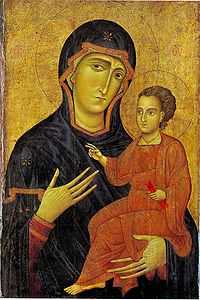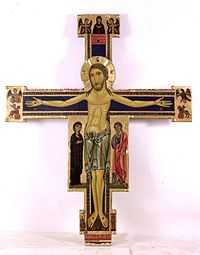Berlinghiero Berlinghieri

Berlinghiero Berlinghieri, also known as Berlinghiero of Lucca, (fl. 1228 – between 1236 and 1240) was an Italian painter of the early thirteenth century. He was the father of the painters Barone Berlinghieri, Bonaventura Berlinghieri, and Marco Berlinghieri.[1]
His actual name is unknown, as he is known from the inscription "Berlingerius me pinxit" on the crucifix which is the basis of attributing other works to him. But the name "Berlinghiero Berlinghieri" is certainly not his name (according to Edward B. Garrison) and he should be called Berlinghiero. He is also mentioned in a parchment of 22 March 1228 among the names of the residents of Lucca who swore to keep the peace with Pisa after a five year's war. The original document has been lost since the mid-19th century and only a somewhat garbled 17th-century transcription exists today, giving rise to the mlistaken interpretation of attributing him a wrong name and a wrong Lombardic origin. [2]
Since his two adult sons were also mentioned in that document, it can be argued that Berlinghiero was then between 35 and 40 years old. This puts his birthday between 1188 and 1193. [2]
His style was late Romanesque, mainly line-based, with neohellenistic and Byzantine influences.[3] He is considered to be one of the main artists of the Tuscan art of the period.
His earliest work, or at least attributed to him, is the "Madonna di sotto gli organi" in the cathedral of Pisa and dates not earlier than 1210.
Works by Berlinghieri can be found at the San Matteo National Museum in Pisa, the Museo nazionale di Villa Guinigi in Lucca, the North Carolina Museum of Art in Raleigh, the Cleveland Museum of Art, and the Metropolitan Museum of Art in New York City.

Notes
- ↑ Berlinghieri - Berlinghiero, Berlinghieri, Barone, Bonaventura, Marco, Crucifix, St Francis and Scenes from his Life
- ↑ 2.0 2.1 Toward a New History of Lucchese Painting, by Edward B. Garrison, The Art Bulletin, Vol. 33, No. 1 (Mar., 1951), pp. 11-31.
- ↑ Berlinghiero biography